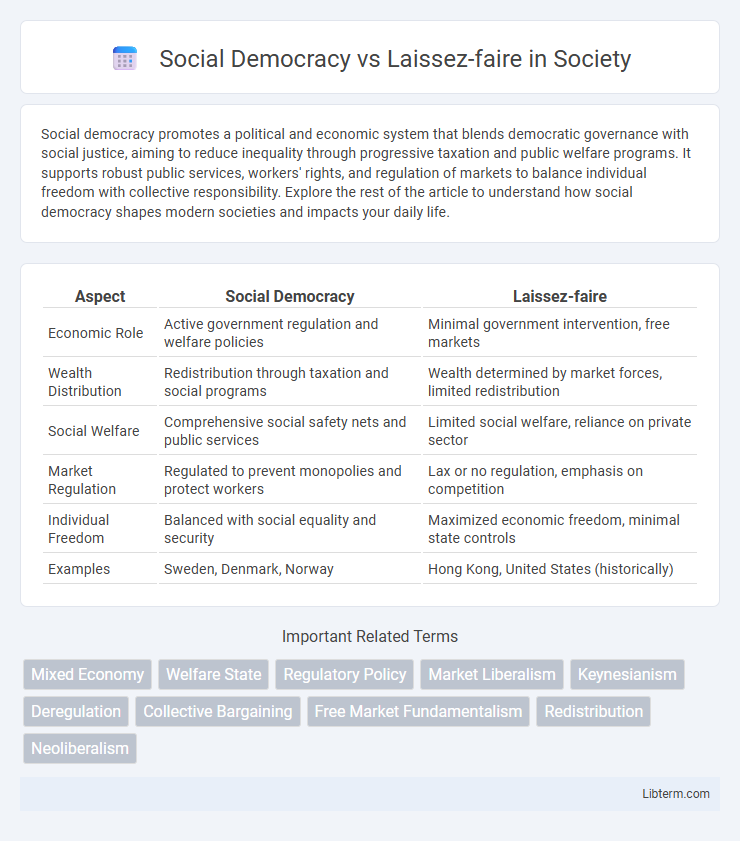Social democracy promotes a political and economic system that blends democratic governance with social justice, aiming to reduce inequality through progressive taxation and public welfare programs. It supports robust public services, workers' rights, and regulation of markets to balance individual freedom with collective responsibility. Explore the rest of the article to understand how social democracy shapes modern societies and impacts your daily life.
Table of Comparison
| Aspect | Social Democracy | Laissez-faire |
|---|---|---|
| Economic Role | Active government regulation and welfare policies | Minimal government intervention, free markets |
| Wealth Distribution | Redistribution through taxation and social programs | Wealth determined by market forces, limited redistribution |
| Social Welfare | Comprehensive social safety nets and public services | Limited social welfare, reliance on private sector |
| Market Regulation | Regulated to prevent monopolies and protect workers | Lax or no regulation, emphasis on competition |
| Individual Freedom | Balanced with social equality and security | Maximized economic freedom, minimal state controls |
| Examples | Sweden, Denmark, Norway | Hong Kong, United States (historically) |
Introduction to Social Democracy and Laissez-faire
Social democracy advocates for a balanced approach combining free market capitalism with government intervention to promote social justice, welfare programs, and equitable wealth distribution. Laissez-faire emphasizes minimal state interference in economic affairs, relying on free markets and individual entrepreneurship to drive growth and efficiency. These contrasting ideologies shape policy debates on regulation, social safety nets, and economic freedoms.
Historical Origins and Evolution
Social democracy emerged in the late 19th century as a response to the inequalities of industrial capitalism, advocating for a regulated market economy combined with extensive social welfare programs to ensure economic justice and reduce social disparities. Laissez-faire capitalism traces its roots to 18th-century classical liberalism, emphasizing minimal government intervention in economic affairs to promote free markets and individual entrepreneurship. Over time, social democracy evolved through reforms and the establishment of welfare states, while laissez-faire principles influenced the development of free-market economies with limited regulatory frameworks.
Core Principles and Philosophies
Social democracy emphasizes a balance between market economy and government intervention to promote social justice, ensuring wealth redistribution, universal healthcare, and social welfare programs. Laissez-faire advocates for minimal government interference, supporting free markets as the most efficient way to allocate resources and encouraging individual entrepreneurial freedom. The core philosophy of social democracy centers on collective responsibility and economic equality, while laissez-faire prioritizes personal liberty and market self-regulation.
Role of Government in the Economy
Social Democracy advocates for a significant government role in regulating the economy to ensure social welfare, equitable wealth distribution, and protection of workers' rights through policies like progressive taxation and social safety nets. In contrast, Laissez-faire emphasizes minimal government intervention, promoting free markets where supply and demand dictate economic outcomes and individuals operate with maximum economic freedom. The government's role in Social Democracy centers on correcting market failures and reducing inequality, whereas Laissez-faire relies on market self-regulation and limited state influence.
Approach to Social Welfare and Public Services
Social democracy promotes extensive social welfare programs and public services funded through progressive taxation to reduce inequality and ensure universal access to healthcare, education, and social security. Laissez-faire emphasizes minimal government intervention, advocating for private sector-driven services where the market dictates availability and quality, often resulting in limited public welfare provisions. The social democratic model supports redistributive policies to protect vulnerable populations, while laissez-faire relies on individual responsibility and market efficiency to address social needs.
Impact on Economic Growth and Stability
Social democracy promotes economic growth and stability by combining market economies with extensive social welfare programs and regulatory frameworks that reduce income inequality and protect workers, leading to sustained consumer demand and reduced economic volatility. Laissez-faire capitalism relies on minimal government intervention, fostering rapid innovation and efficiency but often resulting in higher economic cycles' volatility and greater social disparities. Empirical data from Nordic countries illustrate that social democratic policies correlate with strong GDP growth rates and lower unemployment, while laissez-faire models can exhibit robust growth in boom periods but face increased risks during downturns.
Perspectives on Income Inequality
Social democracy addresses income inequality by advocating for progressive taxation, robust welfare programs, and strong labor protections to redistribute wealth and ensure social equity. Laissez-faire economics promotes minimal government intervention, emphasizing free markets and individual entrepreneurship as mechanisms for wealth creation, which can lead to higher income disparities. Social democrats argue that government policies are essential to mitigate systemic inequalities, while laissez-faire proponents believe market forces naturally regulate economic outcomes.
Citizen Participation and Democratic Structures
Social democracy emphasizes extensive citizen participation through inclusive democratic structures such as proportional representation and multipartism, ensuring diverse voices influence policy decisions. Laissez-faire systems prioritize minimal government intervention, often resulting in limited formal mechanisms for citizen involvement beyond periodic elections. The contrast between these models lies in social democracy's commitment to expanding democratic engagement, whereas laissez-faire upholds individual economic freedom with constrained collective political processes.
Global Examples and Case Studies
Social democracy, exemplified by Scandinavian countries like Sweden and Denmark, emphasizes extensive welfare states, progressive taxation, and robust public services to ensure social equity and economic stability. In contrast, laissez-faire economies such as Hong Kong and Singapore prioritize minimal government intervention, free markets, and deregulation to drive rapid economic growth and innovation. Case studies reveal that social democracies achieve higher social cohesion and lower income inequality, whereas laissez-faire models often generate faster GDP growth but with greater wealth disparities and less comprehensive social safety nets.
Future Trends and Challenges
Social democracy faces future challenges in balancing equitable wealth distribution with economic efficiency amid increasing automation and digital transformation. Laissez-faire capitalism risks deepening inequality and environmental degradation as market-driven forces prioritize short-term profits over sustainable development. Emerging trends point to hybrid models integrating regulatory frameworks with free-market principles to address social welfare while fostering innovation.
Social Democracy Infographic

 libterm.com
libterm.com